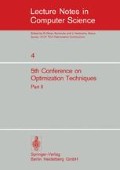Abstract
The concentration of dissolved oxygen in a river has come to be accepted as a criterion of water quality. In-water tests have shown that artificial aeration by means of in-stream mechanical or diffuser type aerators can be an economically attractive supplement or alternative to advanced wastewater treatment as a means of improving water quality.
This paper applies distributed parameter control theory to obtain the aeration rate that maximizes the dissolved oxygen distribution with the least control effort. Both the system state and the control input are distributed in space and time.
A mean square criterion functional is used which allows the optimal feedback control to be determined as a linear function of the state. The feedback gain is found as the solution to the infinite dimensional equivalent to the matrix Riccati equation. An analytic solution for the feedback gain is found for the non-tidal portion of the river, which is modelled by a first order hyperbolic equation. The estuarine portion is described by a diffusion equation, and a numeric solution obtained by approximating the diffusion equation with a finite dimensional system.
An example is given using historical data from the Delaware estuary, and the dollar cost of the optimal control is compared with other ad hoc control strategies.
The research described in this paper was conducted under the supervision of Professor A. V. Balakrishnan while the author was a Research Assistant at the University of California, Los Angeles.
Preview
Unable to display preview. Download preview PDF.
8. References
Harleman, D. R. F. "One Dimensional Models", Estuarine Modeling, an Assessment, U. S. Government Printing Office, Washington, D.C., 1971, Water Pollution Control Research Series, 16070 DZU 02/71.
Koppel, L. B. and Shih, Y. P. "Optimal Control of a Class of Distributed Parameter Systems with Distributed Controls," I&EC Fundamentals, Vol. 7, No. 3, pp. 414–422, 1968.
Lions, J. L. Controle Optimal De Systems Gourvenes Par Des Equations Aux Derivees Partielles, Dunod and Gauthier-Villars, Paris, 1968.
Sage, A. P. Optimum Systems Control, Prentice Hall, Englewood Cliffs, New Jersey, 1968.
Whipple, W., et al "Oxygen Regeneration of Polluted Rivers," Environmental Protection Agency, Washington, D.C., 16080 DUP 12/70, December 1970.
Author information
Authors and Affiliations
Editor information
Rights and permissions
Copyright information
© 1973 Springer-Verlag Berlin Heidelberg
About this paper
Cite this paper
Hullett, W. (1973). Optimal estuary aeration: An application of distributed parameter control theory. In: Conti, R., Ruberti, A. (eds) 5th Conference on Optimization Techniques Part II. Optimization Techniques 1973. Lecture Notes in Computer Science, vol 4. Springer, Berlin, Heidelberg. https://doi.org/10.1007/3-540-06600-4_19
Download citation
DOI: https://doi.org/10.1007/3-540-06600-4_19
Published:
Publisher Name: Springer, Berlin, Heidelberg
Print ISBN: 978-3-540-06600-2
Online ISBN: 978-3-540-37909-6
eBook Packages: Springer Book Archive

